|
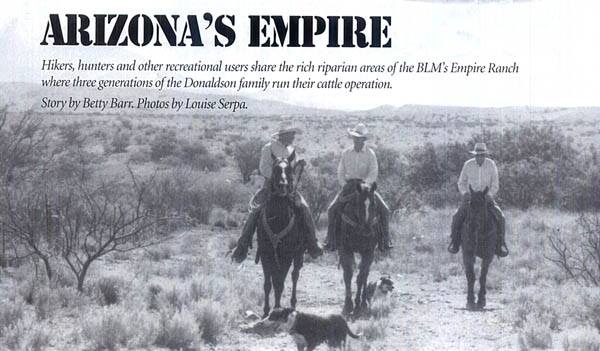
Mac,
Sam and John
ride out to
check cattle
and
country.
By
Betty Barr
The
Empire Ranch
in the high
desert
country of
southeastern
Arizona is
home to many
endangered
species of
flora and
fauna. It
has been
home to
cattle for
more than
100 years.
It is also a
wildlife
corridor
connecting
Mexico to
the Catalina
Mountains
near Tucson
and one of
the main
aquifers
recharging
that
city's
well system.
The
75,000-acre
ranch was
acquired in
1988 by the
Bureau of
Land
Management
(BLM), which
is mandated
by Congress
to provide
for what
they call
"multiple
use."ä The
BLM has to
"meet the
needs of a
broad
spectrum of
the
population"
and the
question
arose as to
where
grazing
could
continue to
fit into the
picture and
share the
110 square
miles with
hikers,
hunters,
horsemen and
bicyclists.
The
Donaldson
family has
leased the
Empire's
rangelands
since the
late 1970s
when the
property was
owned by
Anamax
Mining
Company.
Anamax
needed a
good supply
of water for
their mining
operations
so it also
needed to
keep the
range in
optimum
condition to
ensure a
good supply.
The mining
company&39;s
leaders
asked
conservation-oriented
rancher John
Donaldson,
the
family's
82-year-old
patriarch,
to help
manage the
resource
properly.
"I
saw
something
unique
here,"
Donaldson
says. "It
took about
two days to
figure out
what I
wanted to do
with the
resource,
the
topography,
availability
of water,
the
seasons."
Donaldson
developed a
rest/rotation
plan to
better
utilize the
different
ecosystems
and soil
types, and
eventually
entered into
a beneficial
grazing
lease
agreement
with Anamax.
When the BLM
took over in
1988, the
Donaldsons
had four
years left
on their
lease, but
the future
of grazing
on the
Empire was
in question.
After many
years of
meetings and
input from
various
factions, a
Record of
Decision was
filed in the
Federal
Register
officially
recognizing
grazing as a
multiple use
application.
Donaldson,
along with
his son Mac
and grandson
Sam, now has
a
conventional
Taylor
Grazing
Lease to
continue the
family's
cattle
ranching
operation on
the
property.
The
ranch sees a
lot of
recreational
activity at
all times of
the year by
nature
enthusiasts
and other
outdoorsmen.
Permits for
quail, dove,,
deer,
javelina and
a
reintroduced
species of
antelope
bring a
limited
number of
hunters into
the area.
This
activity,
coupled with
the ongoing
traffic of
illegal
border
crossers
whose camp
and cooking
fires can
get out of
control,,
necessitates
constant
adaptation
on the part
of the
cattlemen.
The
Donaldsons
have planned
their
management
routine to
allow for
frequent
checking of
gates,
fences and
water tanks
during
periods of
heavy use.
The
natural
riparian
area
provides
habitat for
a number of
proposed or
endangered
species
including
the Gila
topminnow,
willow
flycatcher,
Gila chub
and the
Chiricahua
leopard
frog. The
Donaldsons
fence the
cattle out
of the creek
to protect
these
creatures
and to
sustain the
numerous
nonendangered
species that
also thrive
there.
During the
nongrowing
season, the
livestock
still have
access to a
portion of
the river
and are
actually
fenced in on
the adjacent
sacaton-grass
flats.
Grazing
prevents the
grass from
becoming
decadent so
this is to
force-graze
the woody
stalks of
full-grown
sacaton
which are
unpalatable
to cattle.
According
to BLM
wildlife
biologist and
land-use
planner
Karen Simms,
Donaldson's
management
is the
reason for a
dramatic
improvement
in the
riparian
area. The
fencing
program has
been
especially
beneficial
to the
willow
flycatcher
and has
allowed the
fish
population
to be
maintained
at healthy
levels.
Authentic
restoration
of the
original
ranch
buildings is
another
important
program at
the Empire
Ranch.
Walter Vail
and his
partner
Herbert
Hislop
purchased
the first
160 acres in
1876 for
$2,000 in
U.S. gold
coin. This
was the
start of a
long and
colorful
history.
Hislop
eventually
returned to
his native
England
while Vail
continued to
add to the
holdings. By
1881 it was
truly on the
way to
becoming an
empire with
more than
5,000 head
of cattle.
The ranch
included the
Total Wreck
Silver Mine,
a town of
300
residents,
and a toll
road that
controlled
the cattle
trail to the
Southern
Pacific
loading
chutes.
After
Vailās
untimely
death in
1906, his
17-year-old
son Banning
was sent to
Arizona to
learn at the
Empire
Ranch. Seven
years later
he became
the manager.
Banning Vail
and his wife
Laura were
renowned for
their
gracious
hospitality.
When there
were guests
for dinner,
the men
would repair
to the
master
bathroom
after
dessert to
smoke their
cigars and
talk cattle.
They
referred to
it as the
"Gentlemen's
Room."
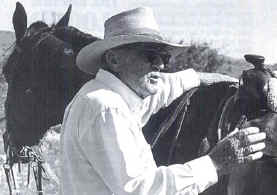
Eighty-two-year-old
John
Donaldson,
above,
runs
the
Empire
Ranch with
as much care
and concern
as if it
were his
own.
This
75,000-acre
outfit in
southeastern
Arizona has
been running
cows
for
more than a
century.
The
ranch was
the site of
a continual
stream of
friends,
relatives
and business
associates,
but what
made the
Empire
really
special was
the large
cast of
characters
who lived
and worked
there. There
was Apache
Joe, the
stoic
Indian,
whose job
was to keep
a continual
supply of
mesquite
firewood on
hand; he
stacked it
in huge
piles and
brought it
up to the
house as
needed in an
old
wheelbarrow.
Ranch hand
Bartolo was
the envy of
the other
cowboys
because his
wife rolled
his
cigarettes
and put them
in a metal
box for him
to take out
on the
range. Mr.
Helmann, the
prim and
proper
bookkeeper
who kept
track of all
the cattle
transactions
and managed
the ranch
store, still
made time
every
morning to
clean all
the canned
goods with a
feather
duster. Then there was the nursemaid who came from across the border
and asked
the family
to give her
an Anglo
name so her
abusive
husband
couldn't
find her;
she was
known as
Sally. In
the
mid-1920s a
terrible
drought
forced the
Vails to
ship their
starving
livestock to
ranches in
Mexico. Soon
afterward
they sold
the ranch.
The
Boice
family's
Chiricahua
Cattle
Company,
dubbed the
Cherry Cows,
purchased
the Empire
in 1928. The
headquarters,
a rock adobe
building
still
standing
today, had a
long
breezeway in
the center
with hooks
to hang
meat, and
screen nets
so the wind
could blow
through.
They had an
old
pensioner
named Dee
who had
cowboyed for
the family
in his
younger
days; he was
in charge of
the
storeroom.
The cowboys
helped make
the jerky.
They cut the
meat in long
pieces,
spread it
out on
tables and
peppered it
thickly,
then hung it
over a wire
to dry. The
crisp strips
were packed
into flour
sacks and
sent out to
camp. The
camp cooks
would take a
hatchet,
break them
up and add
water to
make stew or
fix it in a
skillet with
gravy and
biscuits.
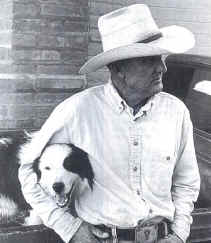
Mac
with a
working
friend.
Gulf
American, a
large
development
company,
bought the
property
from the
Boices in
1960 and
sank a
number of
wells before
reselling it
to Anamax,
when even
more wells
were
drilled.
Southern
Arizona is
always
subject to
drought and
an adequate
water supply
is vital to
both
livestock
and
wildlife.
Those wells
turned out
to be the
key factor
in John
Donaldson's
management
plan.
"We
don't
depend on
windmills,
we don't
depend on
floods to
fill water
tanks,'
son Mac
explains.
'We pump
the water
using a
submersible
pump with a
generator.
When we
rotate the
cows to
another
pasture we
don't have
to worry
about the
water."
The
Donaldsons
try to keep
12 to 18
months
supply of
feed ahead.
Rather than
grazing down
to the
ground they
keep some
reserves, so
when drought
comes they
don't have
to buy feed
for their
cattle.
The
Empire Ranch
has a
magical
quality that
seems to
exert a
lifelong
influence on
those who
have lived
and worked
there. Today
members of
the Vail,
Boice and
Donaldson
families sit
on the board
of the
Empire Ranch
Foundation,
dedicated to
the historic
restoration
of the
original
buildings
and the
creation of
a western
heritage
learning
center.
In
2002, The
National
Cowboy &
Western
Heritage
Museum
presented
John
Donaldson
with the
Chester A.
Reynolds
Memorial
Award. In
January
2004, the
Quivira
Coalition
honored the
Donaldson
family,
along with
the Sonoita
Valley
Planning
Partnership,
with the
third annual
Clarence
Burch Award.
The award
recognizes
innovative
ideas in
ranch
management
that build
bridges
between
ranchers,
environmentalists
and others
to restore
western
rangelands.
The award
includes a
grant of
$15,000 to
the Las
Cienegas
Conservation
area, which
will be used
to enhance
the
resources on
the Empire.
"If
you can't
economically
ranch within
the
environment's
ability to
be
productive
without
using
artificial
means,"
John
Donaldson
states
passionately,
"you
better get
into another
line of
endeavor."
Betty
Barr of
Sonoita,
Ariz.,
retired as
marketing
director of
Safari Club
International
and writes
historical
features for
The Bulletin
and Nogales
International
newspapers.
Tucsonian
Louise Serpa
was the
first woman
to receive a
Rodeo Cowboy
of America
press card
and has been
inducted
into the
National
Cowgirl Hall
of Fame.
THE
EMPIRE:
Looking Back
1876-Walter
Vail and
Herbert
Hislop
purchased
first 160
acres for
$2,000 in
gold coin.
1906-Walter
Vail was
killed in
San
Francisco,
"crushed
between two
streetcars
going in
opposite
directions."
His
17-year-old
son Banning
started
learning the
ropes at the
Empire and
became
manager
seven years
later.
1920s-"Cold-blooded"
(wild)
horses so
overran the
range that
they were
eating grass
needed for
cattle. Vail
rounded up
the horses
and gave
away as many
as his
neighbors
would take.
He spent the
next two
days
shooting the
remainder,
stacking
them in a
wash so that
a cowboy
could walk
across it on
the corpses.
Vail's
daughter
Dusty
remembered
the time as
"harrowing."
Mid
1920s-A
terrible
drought
forced
cattle
owners to
ship their
starving
livestock to
Mexico.
Banning Vail
trailed over
7,000 head
of cattle
south of the
border in
what was to
be
the last
major
Arizona
cattle
drive.
1928-Vail
sold Empire
to the Boice
family's
Chiricahua
Cattle
Company,
dubbed the
Cherry Cows.
1930s
and
'40s-Frank
and Mary
Boice ran
the Empire.
Mary had a
reputation
as a
first-class
hand. She
participated
in all
facets of
ranch life,
including
roundups,
sorting and
shipping. An
account of
the day
says: "She
did
everything
but doctor
for
screw-worms."
Early
1970s-Anamax
Mining
Company
bought the
ranch.
1975-Anamax
brought in
John
Donaldson as
range
management
consultant.
1976-Donaldson
and Anamax
entered into
a beneficial
grazing
lease
agreement.
1988-BLM
acquired the
property
from Anamax
by trading
several
noncontiguous
parcels in
northern
Arizona for
this one
large parcel
more
suitable to
their needs.

Mercantile
chaps were
too big and
stiff for
Dusty Vail
so her
father
talked the
foreman,
Blas Lopes,
into giving
her his
broken-in
chaps.
Photo
Courtesy
Susan Hughes
and the Vail
Family
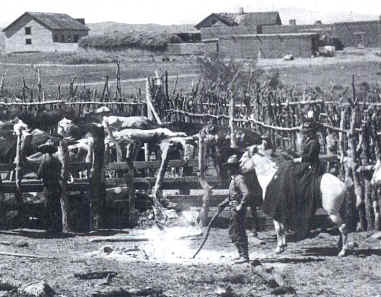
Margaret
Vail,
sidesaddle,
watches
cowboys work.
Photo
Courtesy
Susan Hughes
and the Vail
Family
|

|
|
This
photo of cow
ponies stretching
out a bull
was used on
Vail Ranch
letterhead.
Photo
Courtesy
Susan Hughes
and the Vail
Family
1960-Gulf
American,
a
large
development
company
purchased
the Empire
Ranch. |
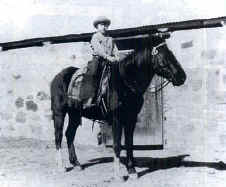
Dusty
Vail on
Coltee. Her
father said,
"I can
tell you a
lot
of
things about
working
cattle but
your best
teacher is
this
horse."
He told her
to watch
Coltee's
ears and the
horse would
show her
what to do.
Photo
Courtesy
Susan Hughes
and the Vail
Family

Dusty
Vail and her
favorite
playmate
Brother
Brown,
son
of the
family cook,
Lena, in
1918.
Lena's
culinary
talent was
the talk of
the
ranch.
Photo
Courtesy
Susan Hughes
and the Vail
Family

Official
Empire Land
and Cattle
Co.
letterhead
incorporated
several
ranch
photos.
Photo
Courtesy
Susan Hughes
and the Vail
Family
Summer
2004
Contents
|











